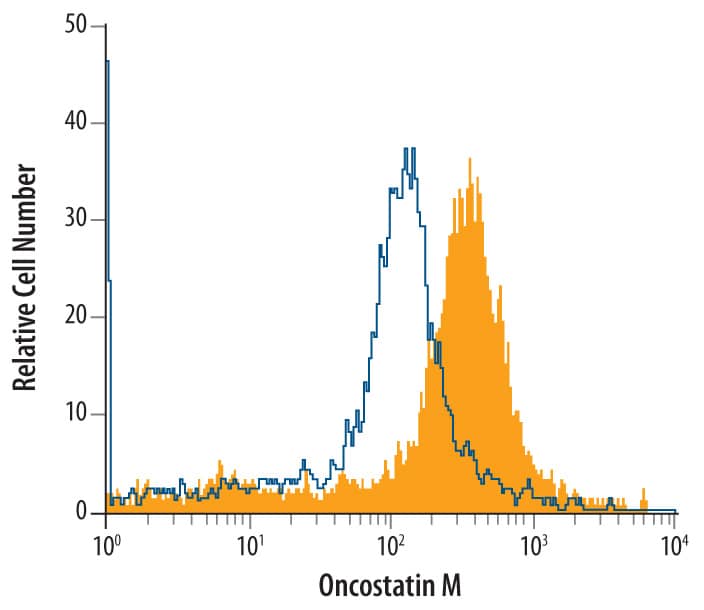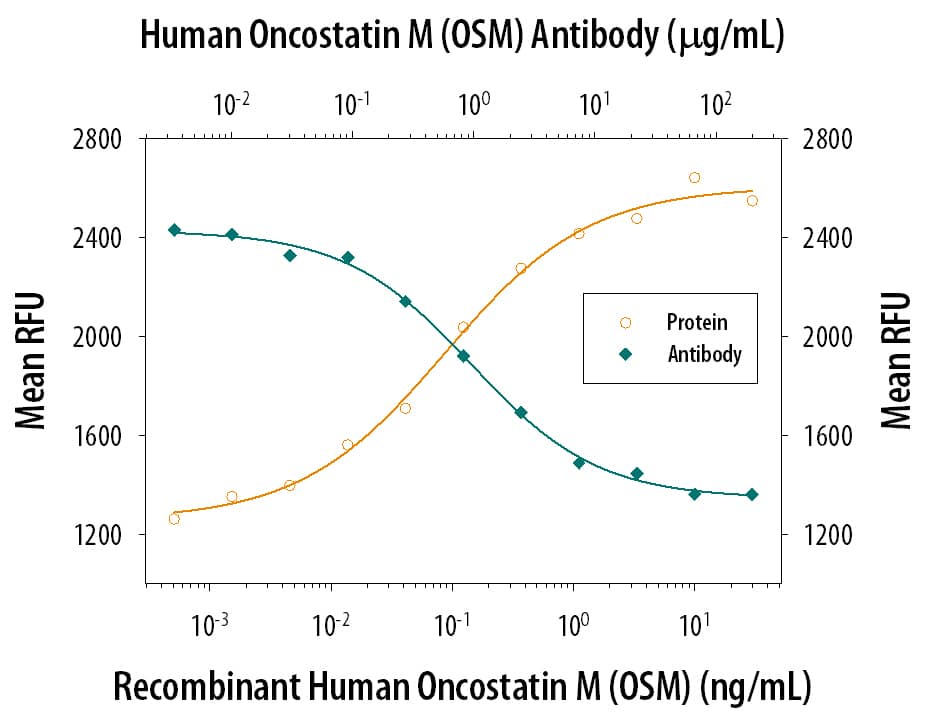Human Oncostatin M/OSM Antibody
R&D Systems, part of Bio-Techne | Catalog # MAB2951


Key Product Details
Species Reactivity
Applications
Label
Antibody Source
Product Specifications
Immunogen
Ala26-Arg221
Accession # P13725
Specificity
Clonality
Host
Isotype
Endotoxin Level
Scientific Data Images for Human Oncostatin M/OSM Antibody
Detection of Oncostatin M/OSM in Human Dendritic Cells by Flow Cytometry.
Human monocyte-derived dendritic cells were stained with Mouse Anti-Human Oncostatin M Monoclonal Antibody (Catalog # MAB2951, filled histogram) or isotype control antibody (Catalog # MAB003, open histogram), followed by Phycoerythrin-conjugated Anti-Mouse IgG Secondary Antibody (Catalog # F0102B). To facilitate intracellular staining, cells were fixed with paraformaldehyde and permeabilized with saponin.Cell Proliferation Induced by Oncostatin M/OSM and Neutralization by Human Oncostatin M/OSM Antibody.
Recombinant Human Oncostatin M (Catalog # 295-OM) stimulates proliferation in the TF-1 human erythro-leukemic cell line in a dose-dependent manner (orange line). Prolif-eration elicited by Recom-binant Human Oncostatin M (2 ng/mL) is neutralized (green line) by increasing concentrations of Mouse Anti-Human Oncostatin M Monoclonal Antibody (Catalog # MAB2951). The ND50 is typically 0.3-1.5 µg/mL.Applications for Human Oncostatin M/OSM Antibody
CyTOF-ready
Intracellular Staining by Flow Cytometry
Sample: Human monocyte-derived dendritic cells, fixed with paraformaldehyde and permeabilized with saponin
Neutralization
Formulation, Preparation, and Storage
Purification
Reconstitution
Formulation
Shipping
Stability & Storage
- 12 months from date of receipt, -20 to -70 °C as supplied.
- 1 month, 2 to 8 °C under sterile conditions after reconstitution.
- 6 months, -20 to -70 °C under sterile conditions after reconstitution.
Background: Oncostatin M/OSM
OSM is a pleiotropic cytokine that initiates its biological activities by binding to specific cell surface receptors. The biological activity of human OSM is mediated either by the LIF/OSM receptor complex composed of gp130 and LIF R alpha or by a human OSM specific receptor composed of gp130 and OSM R alpha. The gp130, a signal transducing component ( beta subunit) of the IL-6, LIF and CNTF receptor complexes, was identified as a low-affinity OSM receptor that does not transduce OSM signals. The low affinity LIF receptor (LIF R, a gp130-related protein) has been identified to be a component of a high-affinity OSM receptor that will transduce OSM signals. Besides its growth inhibitory activities on human A375 melanoma and mouse M1 myeloid leukemic cells, as well as on other solid tumor cells, OSM also has growth stimulatory activities on normal fibroblasts, AIDS-Kaposi’s sarcoma cells, and a human erythroleukemia cell line, TF-1. Other OSM-mediated activities reported to date include: stimulation of plasminogen activator activity in cultured bovine aortic endothelial cells; regulation of IL-6 expression in human endothelial cells; and stimulation of LDL uptake and up-regulation of cell surface LDL receptors in HepG2 cells.
Alternate Names
Gene Symbol
UniProt
Additional Oncostatin M/OSM Products
Product Documents for Human Oncostatin M/OSM Antibody
Product Specific Notices for Human Oncostatin M/OSM Antibody
For research use only
